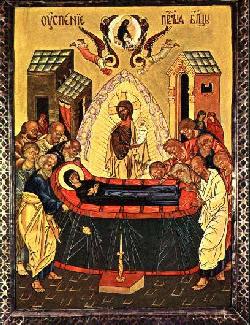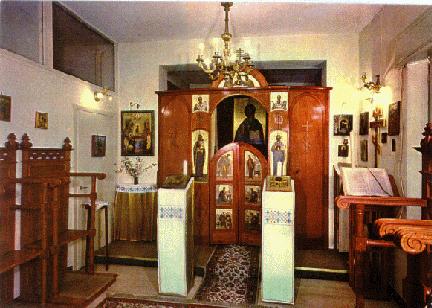Monastero della Dormizione di Maria
'Uspenskij'
Tel. (+39) 06 - 6615 2344
e-mail: dormizione@tiscali.it
A russian convent in Rome
In 1957 a further addition was made to the great variety of religious institutions which emphasize the sacred character of the city housing the Holy Father. Rome wished to have a house in which "virgins consecrated to God by assiduous prayer and practice of the virtues implore the mercy of God for the Russian peoples," as His Eminence Cardinal E. Tisserant writes in the preface to the Constitutions of this convent.
In the same document the Cardinal explains how, in an audience on April 11th, 1956, in his capacity as Secretary of the Sacred Congregation for the Eastern Churches, he submitted to His Holiness Pope Pius XII the plan for the foundation of the convent, for which he received approval and encouragement.
It was the Sacred Congregation for the Eastern Churches which desired to make the foundation. Due, in particular, to the kindness of His Eminence, the Assessor, Rev. Father Coussa, who on becoming a Cardinal continued to show his paternal interest, a house was found which sufficed for a start. (it is 15 minutes distant by bus--nos. 808 or 881--from St. Peter's Square)
A "Typicum" ('Ustav' or Constitution) was compiled in Russian and in Latin, according to the traditional scheme of Russian convents and on a basis of Eastern Catholic Canon Law. Both parts of this document--Typicum Ktetoricum and Typicum Asceticum--were approved by the Sacred Congregation for the Eastern Churches on June 29th and August 15th, 1958.
At the same time, four Russian nuns belonging to different Orders and Congregations and from various countries, to whom the ideal of this foundation had been proposed, commenced in Rome their new monastic life.
On July 10th, 1959 Pope John XXIII, in virtue of his authority as Prefect of the Sacred Congregation for the Eastern Churches, was pleased to raise the institution to the dignity of pontifical right and to admit to solemn vows the nuns already assembled in the little convent, which, as is written in the document of establishment, "is in some way an ornament of the diocese, a symbol, an invitation and a token of union."
The particular benevolence of the Sovereign Pontiffs was once more manifest when Pope Paul VI received the nuns in special audience when they came to present him with an icon of St Paul painted by one of the nuns. The Pope blessed the nuns and their intentions, adding word of encouragement "You are the root in view of the future," he said, and promising special prayers. Pope John Paul II also invited the community to his private chapel for the celebration of Holy Mass.
Like Moscow's cathedral and thousands of Russian
churches,  the convent is dedicated to the Most Holy Mother of God,
honoured in the mystery of her "Uspenie" or "Falling asleep" (her Assumption, as
Western world prefers to call it).
the convent is dedicated to the Most Holy Mother of God,
honoured in the mystery of her "Uspenie" or "Falling asleep" (her Assumption, as
Western world prefers to call it).
patronal icon of monastery to left
The principal aim of the monastery is the contemplative and liturgical life, and each day the little community of Roman 'Uspenskij' recites or sings the Divine Office in the ancient Slav language, using books printed in Russia.
Silence and solitude favour the continual seeking of evangelical perfection and intimacy with God, in prayer, alternated with work. For the moment the nuns devote themselves particularly to making liturgical vestments for the different Eastern rites, to painting icons, translating, etc.
In the 'Uspenskij' convent the Russian nuns have been joined by some young women and nuns of different nationalities who are particularly attracted by Eastern monasticism, by the Byzantine rite and a love for the ideal and the form of life of this community. Spiritual assistance is facilitated for these by the presence in Rome of two institutions, namely, the 'Pontifical Oriental Institute' and the 'Russian Pontifical Seminary,' whose priests have been devoted with both kindness and competence to the convent from the outset.
The progressive stages of the monastic life are those observed in
the Russian tradition. There are three years of novitiate preceded by several
months of trial; rjasophorat, or minor profession, in
itself perpetual, but in which at least five years must be spent. Then comes
major profession with the little habit, microscheme,
which sometimes, after at least 30 years of exemplary religious life on the part
of those more dedicated to prayer and penance, may be completed by the
megaloscheme or profession of the great
habit.
"One flock, one shepherd." In the little chapel which is the heart of the convent, the figure of Christ painted on the iconostasis holds the Gospel open at the page on which is written the ardent desire of Christ for the unity of his Church, as St John (Jn. 10: 16) has passed it on to us.
These words remind the Sisters that they must pray in order that the obstacles which delay the restoration of unity among Christians may be overcome. The little Roman Uspenskij wishes to be a response to the heavenly invitation of the Blessed Virgin of Fatima. Moreover, in concluding these brief informative notes, the nuns ask all who have occasion to read them to pray that they may correspond more fully each day to God's merciful plan, by continuing their life "hidden with Christ in God".
Links
A Directory of Russian Catholic Communities and Centers
| This page in italian... | This page in russian... |
|
|
Copyright © 2003 -2005 Dormizione, Rome, Italy |